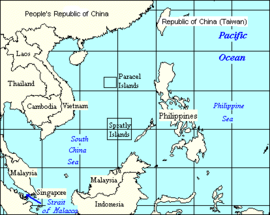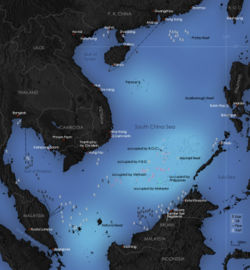South China Sea
2007 Schools Wikipedia Selection. Related subjects: General Geography
The South China Sea is a marginal sea south of China. It is a part of the Pacific Ocean, encompassing an area from Singapore to the Strait of Taiwan of around 3,500,000 km². It is the largest sea body after the five oceans. The minute South China Sea Islands, collectively an archipelago, number in the hundreds. The sea and its mostly uninhabited islands are subject to several competing claims of sovereignty by neighboring nations. These competing claims are also reflected in the variety of names used for the islands and the sea.
Geography
The International Hydrographic Organization defines the sea as stretching in a southwest to northeast direction, whose southern border is 3 degrees South latitude between South Sumatra and Kalimantan ( Karimata Strait), and whose northern border is the Strait of Taiwan from the northern tip of Taiwan to the Fujian coast of mainland China. The Gulf of Thailand covers the western portion of the South China Sea.
The sea lies above a drowned continental shelf; during recent ice ages global sea level was hundreds of meters lower, and Borneo was part of the Asian mainland.
States and territories with borders on the sea (clockwise from north) include: the mainland China, Macao, Hong Kong, Taiwan, the Philippines, Malaysia, Brunei, Indonesia, Singapore, Thailand, Cambodia, and Vietnam.
Major rivers that flow into the South China Sea include the Pearl, Min, Jiulong, Red, Mekong, Rajang, Pahang, and Pasig Rivers.
Islands and seamounts
Within the sea, there are over 200 identified islands and reefs, most of them within the Spratly Islands. The Spratly Islands spread over an 810 by 900 km area covering some 175 identified insular features, the largest being Taiping Island (Itu Aba) at just over 1.3 km long and with its highest elevation at 3.8 metres.
There is a 100- km wide seamount called Reed Tablemount in NE Spratlys, separated from Palawan Island of the Philippines by the Palawan Trench. Now about 20m under the sea level it was an island until it sunk about 7,000 years ago due to the increasing sea level after the last ice age.
Territorial claims
Competing territorial claims over the South China Sea and its resources are numerous. Because the 1982 United Nations Law of the Sea allows for a country's Exclusive Economic Zone (EEZ) to extend 200 nm (370.6 km) beyond territorial waters, all the nations surrounding the sea can lay claim to great portions of it. The People's Republic of China (PRC) has stated its claim to almost the entire body. Recent reports indicate the PRC is building an aircraft carrier battle group to secure energy lines in the South China Sea. Areas with potential problems include:
- Indonesia and the PRC over waters NE of the Natuna Islands.
- The Philippines and the PRC over the Malampaya and Camago gas fields.
- The Philippines and the PRC over Scarborough Shoal.
- Vietnam and the PRC over waters west of the Spratly Islands. Some or all of the islands themselves are also disputed between Vietnam, the PRC, the ROC, Brunei, Malaysia, and the Philippines.
- The Paracel Islands are disputed between the PRC/ROC and Vietnam.
- Malaysia, Cambodia, Thailand and Vietnam over areas in the Gulf of Thailand.
- Singapore and Malaysia along the Straits of Johore and the Straits of Singapore.
The PRC and Vietnam have both been vigorous in prosecuting their claims. The Paracel Islands was seized by China in 1974 and 18 soldiers were killed. The Spratly Islands have been the site of a naval clash, in which over seventy Vietnamese sailors were killed just south of Chigua Reef in March 1988. Disputing claimants regularly report clashes between naval vessels.
ASEAN in general, and Malaysia in particular, has been keen to ensure that the territorial disputes within the South China Sea do not escalate into armed conflict. As such, Joint Development Authorities have been setup in areas of overlapping claims to jointly develop the area and dividing the profits equally without settling the issue of sovereignty over the area. This is true, particularly in the Gulf of Thailand.
The overlapping claims over Pedra Branca or Pulau Batu Putih by both Singapore and Malaysia has been brought to the International Court of Justice and the case is expected to be heard in 2007.
Names for the sea
South China Sea is the dominant term used in English for the sea, and the name in most European languages is equivalent, but it is sometimes called by different names in neighboring countries, often reflecting historical claims to hegemony over the sea.
The English name is a result of early European interest in the sea as a route from Europe and South Asia to the trading opportunities of China. In the sixteenth century Portuguese sailors called it the China Sea (Mare da China); later needs to differentiate it from nearby bodies of water lead to calling it the South China Sea.
In China, the traditional name for the sea is Southern Sea (南海; Nánhǎi). In contemporary Chinese publications, it is commonly called South China Sea (南中國海, Nán Zhōnggúo Hǎi), and this name is often used in English-language maps published by China. In Vietnam, it is called the Eastern Sea (Biển Đông); this name is sometimes used by Vietnamese mapmakers in foreign-language publications. In the Philippines, it is sometimes called the Luzon Sea, after the major Philippine island of Luzon. In Southeast Asia, it was once called the Champa Sea or Sea of Cham, after the Malayo-Polynesian maritime kingdom that flourished before the sixteenth century.

